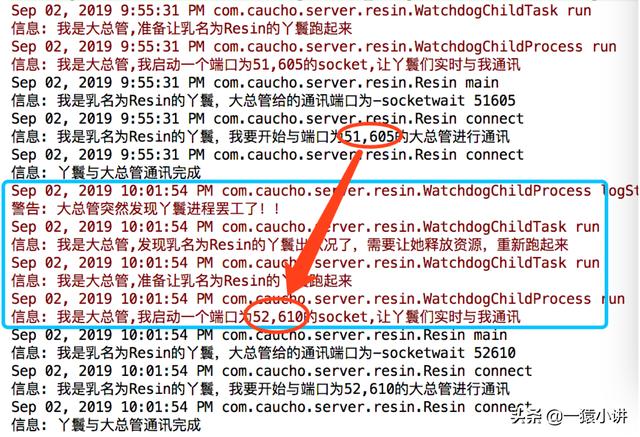各位坐稳扶好,我们要开车了。不过在开车之前,我们还是例行回顾一下上期分享的要点。
经过前两期的铺垫及烧脑的分享,我们大概对「如何实现 Java 应用进程的状态监控,如果被监控的进程 down 掉,是否有机制能启动起来?」问题本身有了一个新的认识,那这期我们不妨拿出攻城狮的绝招 Ctrl + C、Ctrl + V,从 Resin 源码中摘取一二,稍微简单实践一下。

按照图示,咱们先演示一下实践效果吧,首先找到并运行程序入口 MonitorApp,日志输出如下。

此时我们不妨在控制台输入 jps 命令,看一看效果。
18830 MonitorApp
18831 Resin
发现成功启动了 MonitorApp、Resin 两个进程,和 Resin 应用服务器是一模一样的,如果我们把进程号为 18831 的 kill 掉,会是什么效果?发现控制台日志输出又多了一些,貌似丫鬟 Resin 又被重新给启动了。

在控制台输入 jps 命令再确认一下是否真的变了。
18830 MonitorApp
18935 Resin
那我们到底该如何实现?那不妨照葫芦画瓢,模仿一下 Resin 的实现一下(这就是绝招:仿一仿)。
首先定义我们的监控应用入口 MonitorApp,很简单就是把创建子进程的任务给启动起来。
package com.caucho. server .resin;
public class MonitorApp {
public static void main(String[] args) {
new WatchdogChildTask().start();
}
}
接下来再编写 WatchdogChildTask 子进程任务的代码,大部分来源于 Resin 的源码,只是剔除了很多很多很多,简化了很多很多很多。仔细看发现也很简单,就有一个循环一直调用 WatchdogChildProcess 的 run 方法,目的也就是一直让丫鬟进程跑起来。
package com.caucho.server.resin;
import java.util.concurrent.Executors;
import java.util.logging.Level;
import java.util.logging.Logger;
class WatchdogChildTask implements Runnable {
private static final log ger log = Logger.getLogger(WatchdogChildTask.class.getName());
private WatchdogChild process _process;
/**
* Starts management of the watchdog process
*/ public void start() {
//TODO 手动创建线程池会更好 【 阿里 开发规约】
Executors.newFixedThreadPool(1).execute(this);
}
/**
* Main thread watching over the health of the Resin instances.
*/ public void run() {
try {
int i = 0;
long retry = Long.MAX_VALUE;
while (i++ < retry) {
WatchdogChildProcess process = new WatchdogChildProcess();
_process = process;
try {
log.log(Level.INFO, "我是大总管,准备让乳名为Resin的丫鬟跑起来");
_process.run();
} catch (Exception e) {
log.log(Level.WARNING, e.toString(), e);
} finally {
_process = null;
if (process != null) {
log.log(Level.INFO, "我是大总管,发现乳名为Resin的丫鬟出状况了,需要让她释放资源,重新跑起来");
process.kill();
}
}
}
} catch (Exception e) {
log.log(Level.WARNING, e.toString(), e);
} finally {
if (_process != null) {
_process.kill();
_process = null;
}
}
}
}
具体是怎么把丫鬟进程跑起来的,这个事情专门交给 WatchdogChildProcess 去做了,先启动了一个 socket 通讯端口;然后采用 ProcessBuilder 启动 Resin 进程;然后等待丫鬟进程建立 socket 连接通讯。大部分也是来源于 Resin 的源码,只不过做了大量删减。另外重点提一嘴:拿下去只需修改 com.caucho.server.resin.Resin 为你要监控应用的主函数即可。
package com.caucho.server.resin;
import java.io.*;
import java.net.*;
import java.util.*;
import java.util.concurrent.atomic.AtomicReference;
import java.util.logging.Level;
import java.util.logging.Logger;
class WatchdogChildProcess {
private static final Logger log = Logger.getLogger(WatchdogChildProcess.class.getName());
private Socket _childSocket;
private OutputStream _stdOs;
private int _status = -1;
private AtomicReference<Process> _processRef = new AtomicReference<Process>();
public void run() {
ServerSocket ss = null;
Socket s = null;
try {
ss = new ServerSocket(0, 5, InetAddress.getByName("127.0.0.1"));
int port = ss.getLocalPort();
log.log(Level.INFO, "我是大总管,我启动一个端口为{0}的socket,让丫鬟们实时与我通讯",port);
Process process = createProcess(port);
if (process != null) {
_processRef.compareAndSet(null, process);
InputStream stdIs = process.getInputStream();
_stdOs = process.getOutputStream();
//TODO 不要显式创建线程,请使用线程池【 阿里 开发规约】
new Thread(new WatchdogProcessLogThread(stdIs)).start();
s = connectToChild(ss);
_status = process.waitFor();
logStatus(_status);
}
} catch (Exception e) {
log.log(Level.WARNING, e.toString(), e);
try {
Thread.sleep(5000);
} catch (Exception e1) {
}
} catch (Throwable e) {
log.log(Level.WARNING, e.toString(), e);
} finally {
if (ss != null) {
try {
ss. close ();
} catch (Throwable e) {
}
}
try {
if (s != null) {
s.close();
}
} catch (Throwable e) {
log.log(Level.FINER, e.toString(), e);
}
kill();
synchronized (this) {
notifyAll();
}
}
}
private void logStatus(int status) {
String code = " (exit code=" + status + ")";
log.warning("大总管突然发现丫鬟进程罢工了!!");
}
void kill() {
Process process = _processRef.getAndSet(null);
if (process != null) {
try {
process.destroy();
} catch (Exception e) {
log.log(Level.FINE, e.toString(), e);
}
}
OutputStream stdOs = _stdOs;
_stdOs = null;
if (stdOs != null) {
try {
stdOs.close();
} catch (Throwable e) {
log.log(Level.FINE, e.toString(), e);
}
}
Socket childSocket = _childSocket;
_childSocket = null;
if (childSocket != null) {
try {
childSocket.close();
} catch (Throwable e) {
log.log(Level.FINE, e.toString(), e);
}
}
if (process != null) {
try {
process.waitFor();
} catch (Exception e) {
log.log(Level.INFO, e.toString(), e);
}
}
}
/**
* Waits for a socket connection from the child, returning the socket
*
* @param ss TCP ServerSocket from the watchdog for the child to connect to
*/ private Socket connectToChild(ServerSocket ss)
throws IOException {
Socket s = null;
try {
ss.setSoTimeout(60000);
for (int i = 0; i < 120 && s == null; i++) {
try {
s = ss.accept();
} catch (SocketTimeoutException e) {
}
}
if (s != null) {
_childSocket = s;
}
} catch (Exception e) {
log.log(Level.WARNING, e.toString(), e);
} finally {
ss.close();
}
return s;
}
/**
* Creates a new Process for the Resin JVM, initializing the environment
* and passing value to the new process.
*
* @param socketPort the watchdog socket port
* @param out the debug log jvm-default.log
*/ private Process createProcess(int socketPort)
throws IOException {
HashMap<String, String> env = buildEnv();
ArrayList<String> jvmArgs = buildJvmArgs();
jvmArgs.add("com.caucho.server.resin.Resin");
jvmArgs.add("-socketwait");
jvmArgs.add(String.valueOf(socketPort));
ProcessBuilder builder = new ProcessBuilder();
builder.environment().putAll(env);
builder = builder.command(jvmArgs);
builder.redirectErrorStream(true);
return builder.start();
}
private HashMap<String, String> buildEnv()
throws IOException {
HashMap<String, String> env = new HashMap<String, String>();
env.putAll(System.getenv());
StringBuilder classPath = new StringBuilder();
// TODO 系统不一样分割符也不同 windows为分号;
classPath. append (".:");
String appPath = System.getProperty("user.dir");
classPath.append(appPath).append("/resin/target/classes");
env.put("CLASSPATH", classPath.toString());
// 。。。删除了可多可多的代码 。。。
return env;
}
private ArrayList<String> buildJvmArgs() {
ArrayList<String> jvmArgs = new ArrayList<String>();
jvmArgs.add("java");
// ... 又删除了可多代码 ...
return jvmArgs;
}
/**
* Watchdog thread responsible for writing jvm-default.log by reading the
* JVM's stdout and copying it to the log.
*/ class WatchdogProcessLogThread implements Runnable {
private InputStream _is;
/**
* @param is the stdout stream from the Resin
*/ WatchdogProcessLogThread(InputStream is) {
_is = is;
}
@Override
public void run() {
try {
int len;
byte[] data = new byte[4096];
while ((len = _is.read(data, 0, data.length)) > 0) {
System.out.print(new String(data, 0, len));
}
} catch (Throwable e) {
log.log(Level.WARNING, e.toString(), e);
} finally {
kill();
}
}
}
}
下面这个要重点说下,因为这套模型你拿过去,只需修改下面 Resin 这个类的代码,这个其实也就是我们要监控的应用。其实很简单,就有一个 connect 方法主要用于与大总管进行通讯,一旦通讯失败本身就退出。
package com.caucho.server.resin;
import java.io.IOException;
import java.io.InputStream;
import java.net.Socket;
import java.util.concurrent.ExecutorService;
import java.util.concurrent.Executors;
import java.util.logging.Level;
import java.util.logging.Logger;
public class Resin {
private static ExecutorService executorService = Executors.newFixedThreadPool(1);
private static final Logger log = Logger.getLogger(Resin.class.getName());
public static void main(String[] args) {
log.log(Level.INFO, "我是乳名为Resin的丫鬟,大总管给的通讯端口为{0} {1}", args);
//获取传入的参数 port
int port = Integer.parseInt(args[1]);
connect(port);
}
public static void connect(final int port) {
log.log(Level.INFO, "我是乳名为Resin的丫鬟,我要开始与端口为{0}的大总管进行通讯",port);
executorService.execute(new Runnable() {
@Override
public void run() {
Socket socket = null;
try {
socket = new Socket("127.0.0.1", port);
InputStream s = socket.getInputStream();
byte[] buf = new byte[1024];
int len;
while ((len = s.read(buf)) != -1) {
log.log(Level.INFO, "通讯信息 {0}", new String(buf, 0, len));
}
} catch (IOException e) {
log.log(Level.WARNING, "我是乳名为Resin的丫鬟,与端口为{0}的大总管进行通讯发生异常",port);
} finally {
try {
socket.close();
} catch (IOException e) {
log.log(Level.WARNING, e.getMessage(), e);
}
log.log(Level.INFO, "我是乳名为Resin的丫鬟,与端口为{0}的大总管进行通讯结束,我要退下啦",port);
System.exit(0);
}
}
});
log.log(Level.INFO, "丫鬟与大总管通讯完成");
}
}
到这,代码也就码完了,不妨把代码拔下去,运行一下,稍微体验体验,看看是不是那回事儿!其中为了演示需要删除了 N 多代码,有些地方很不优雅,还需按照 阿里 开发规约适当调整调整,不过这些不是咱们这期分享的重点,咱们重点是思想 + 轻实践。
好了,思想也落地了,接下来就看你怎么让它老树开新花啦。分享就到这儿吧,希望能够解你所惑;希望能在你前进的道路上,帮你披荆斩棘。如果感觉有点帮助,欢迎点赞,疯狂分享转发,因为你的每一次分享,我都认真当成了鼓励与喜欢。
推荐阅读:


